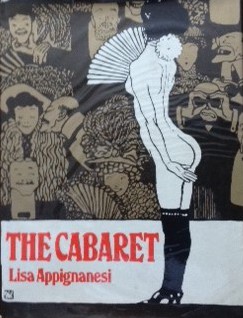Inspiring Older Readers
 posted on 16 Jul 2016
posted on 16 Jul 2016
The Cabaret by Lisa Appignanesi
When a book is both a lovely thing to browse through and informative, intelligent and elegantly written it’s a real bonus. What Appignanesi has done here is to trace the historic, cultural and political significance of the experience we call ‘the cabaret’, taking us on a journey from the mid-nineteenth century through to late twentieth century manifestations that we have come to think of as ‘the fringe’ or satirical reviews.
Although a case can be made for some version of cabaret having always been with us, this book argues that our modern understanding of the word attributes definable characteristics to it: it is essentially a blend of music hall, variety show and carnival overlaid by serious artistic and satirical intent. She also claims that the setting is crucial to the experience – a small stage, intimacy with the performers with drink and conversation amongst the audience itself.
This type of cabaret show has its origins in Paris but quickly migrated east across Europe and by the 1920s it was a key component of the German cultural experience. It’s central role in the Weimar Republic and in Munich, Berlin and other major cities is perhaps best known through the images created by the movie, Cabaret, a loose adaptation of the stories of Christopher Isherwood. This tends to focus on the way cabaret showcased a sexual liberality – even a decadence – that is often seen as a sign of a society in crisis.

However, despite these links to the disreputable, it is in Germany that cabaret developed its explicit links with exciting art movements such as Dada and Surrealism and produced some extraordinary writing – essays and novels - as well. In these years cabaret was a weapon of political discourse and satirical commentary much more than it was a variety entertainment.
This incarnation, it can be argued, never went away and constantly popped up in mutated formats – producing performers as diverse as American stand-up, Lenny Bruce, and the influential British television satire, That Was The Week That Was (also commonly referred to as TW3).
Alongside this fascinating content, the book itself is a lovely thing to leaf through. There are both colour and black and white illustrations – many of them reproductions of the original posters that advertised the cabaret shows. Appignanesi takes her visuals from a range of sources in addition to the posters and we get some documentary photographs, political cartoons and even stills from key movies which have themselves become iconic – Marlene Dietrich, for example, in the film Blue Angel.

What I really like about books like this is that they can be read in lots of different ways. You can sit down and read the essay from beginning to end and be totally engaged with that; or, because the text is well signposted, you can dip in and out or reread those parts of most interest. Then there is coffee-table experience of just picking up the book more casually and finding something new in the illustrations that you hadn’t noticed before.
If you are interested in this topic I’d say this is a book you really need to have on your shelves. Copies are available on the second-hand market that aren’t necessarily cheap but pretty accessible if you’re happy to pay over £10.
Terry Potter
July 2016




